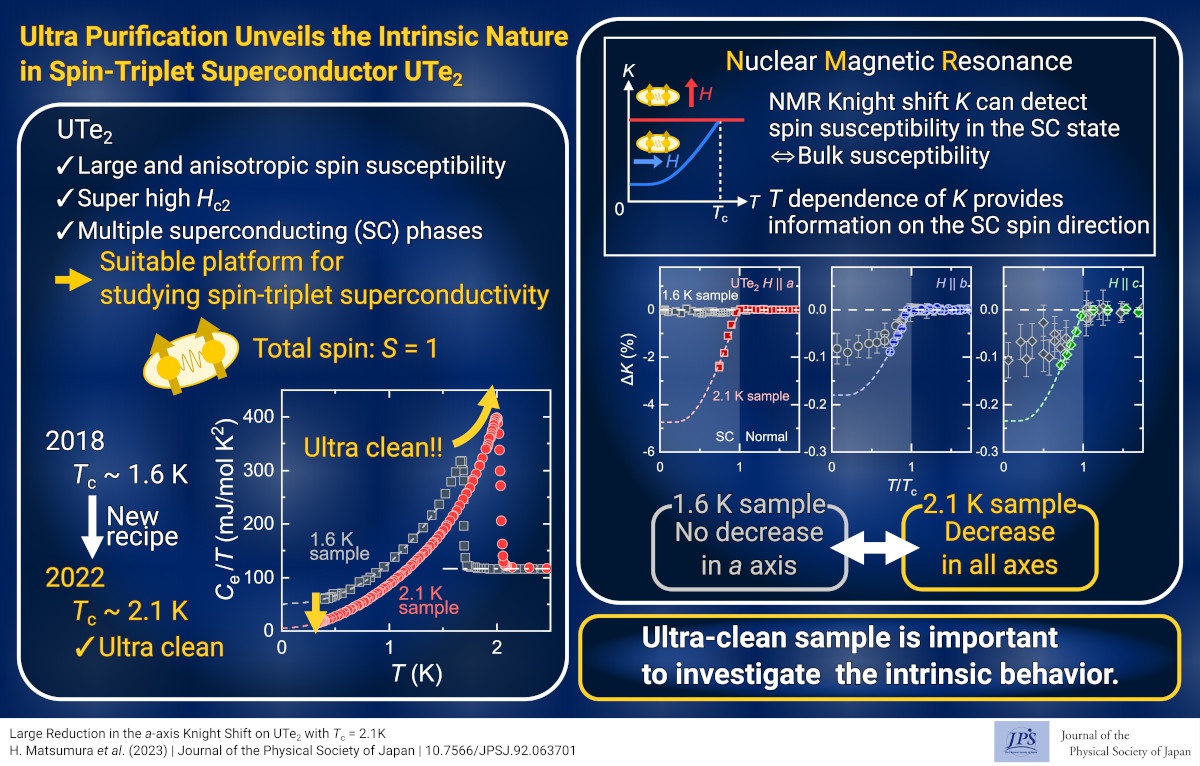Ultra Purification Unveils the Intrinsic Nature in Spin-Triplet Superconductor UTe2
© The Physical Society of Japan
This article is on
Large Reduction in the a-axis Knight Shift on UTe2 with Tc = 2.1 K
J. Phys. Soc. Jpn. 92, 063701 (2023).
Microscopic spin-susceptibility measurements in ultra-pure UTe2 samples reveal that superconducting symmetry is analogous to the superfluidity of the 3He B-phase and that U deficiency has a significant impact on superconducting properties.

Superconductivity is a coherent quantum-mechanical state formed by electron pairs. Superconducting order parameters can be described using combinations of spin and orbital states. Although there are no spin degrees of freedom in the spin-singlet superconducting state, unique properties such as multiple superconducting states and spin rotation of a superconducting pair are expected in the spin-triplet superconducting state, owing to the presence of spin degrees of freedom. However, almost all discovered superconductors belong to the spin-singlet superconductors, with only a few spin-triplet superconductors reported thus far.
In 2018, superconductivity in UTe2 was discovered. UTe2 was initially classified as a spin-triplet superconductor owing to similarities with U-based ferromagnetic superconductors with spin-triplet pairing. In fact, characteristic features of the spin-triplet superconductor, such as an extremely large upper critical field Hc2 and superconducting multiple phases, were observed in UTe2. In NMR measurements, our group obtained various results confirming the spin-triplet state.
In 2022, a significant improvement in sample quality was achieved by changing the synthesis method from chemical-vapor-transport to molten-salt flux method. The new samples showed an increase in Tc from 1.6 to 2.1 K. The residual specific heat coefficient at T → 0, which was approximately half of the normal-state value in the 1.6 K sample, was nearly zero in the 2.1 K sample, indicating the ultra-pure nature of the 2.1 K sample.
To elucidate the intrinsic superconducting symmetry of UTe2, we performed NMR measurements on the 2.1 K sample. Because of the Meissner effect, bulk magnetization measurements cannot be used to determine spin susceptibility in the superconducting state; hence, NMR measurements are the only technique used. The results of NMR measurements for magnetic fields along three crystal axes revealed that the spin susceptibility in the a axis, which did not decrease in the 1.6 K samples, decreased significantly in the 2.1 K samples. However, the spin susceptibility in the b and c axes remained approximately the same as that in the 1.6 K samples. The results in the 2.1 K sample suggest that the possible superconducting state is the spin-triplet Au state, which is the same pairing state as the superfluidity 3He B-phase. This superconducting state is a strong candidate for the topological superconductor, in which the Majorana surface state is anticipated.
Our findings highlight the importance of ultra-pure samples for investigating the essential behavior of superconductivity.
(written by H. Matsumura on behalf of all authors.)
Large Reduction in the a-axis Knight Shift on UTe2 with Tc = 2.1 K
J. Phys. Soc. Jpn. 92, 063701 (2023).
Share this topic
Fields
Related Articles
-
Antiferromagnetism Induces Dissipationless Transverse Conductivity
Electronic transport in condensed matter
Magnetic properties in condensed matter
Electronic structure and electrical properties of surfaces and nanostructures
2024-7-24
An investigation using high-quality NbMnP crystals demonstrates that the anomalous Hall conductivity arising from antiferromagnetism is dissipationless, as expected from the intrinsic mechanism.
-
Structural Rotation and Falsely Chiral Antiferromagnetism: A New Combination Generating Ferrotoroidic State
Magnetic properties in condensed matter
Dielectric, optical, and other properties in condensed matter
2024-7-4
The ferrotoroidic state, an exotic state of matter with broken space inversion and time-reversal symmetries, was achieved by combining structural rotation and falsely chiral antiferromagnetism in PbMn2Ni6Te3O18.
-
Understanding Electronic Ordering and Cross Correlations with Multipole Representation
Magnetic properties in condensed matter
2024-6-12
This study reviews the recent advancements in research of multipole representations for understanding electronic orderings and cross-correlations in materials and presents future research directions.
-
Microscopic Exploration of Electronic States in Nickelate Superconductors
Magnetic properties in condensed matter
Superconductivity
2024-5-31
The multilayered nickelates, La3Ni2O7 and La4Ni3O10 , were investigated using nuclear magnetic resonance (NMR) at ambient pressure. Metallic electronic states under the density wave order were observed microscopically for both compounds.
-
Single-Crystal Growth of a Cuprate Superconductor with the Highest Critical Temperature
Superconductivity
2024-5-20
Millimeter-sized single crystals of a trilayer cuprate superconductor (Hg,Re)Ba2Ca2Cu3O8+δ that exhibits the highest superconducting transition temperature under ambient pressure, were grown reproducibly and safely.
